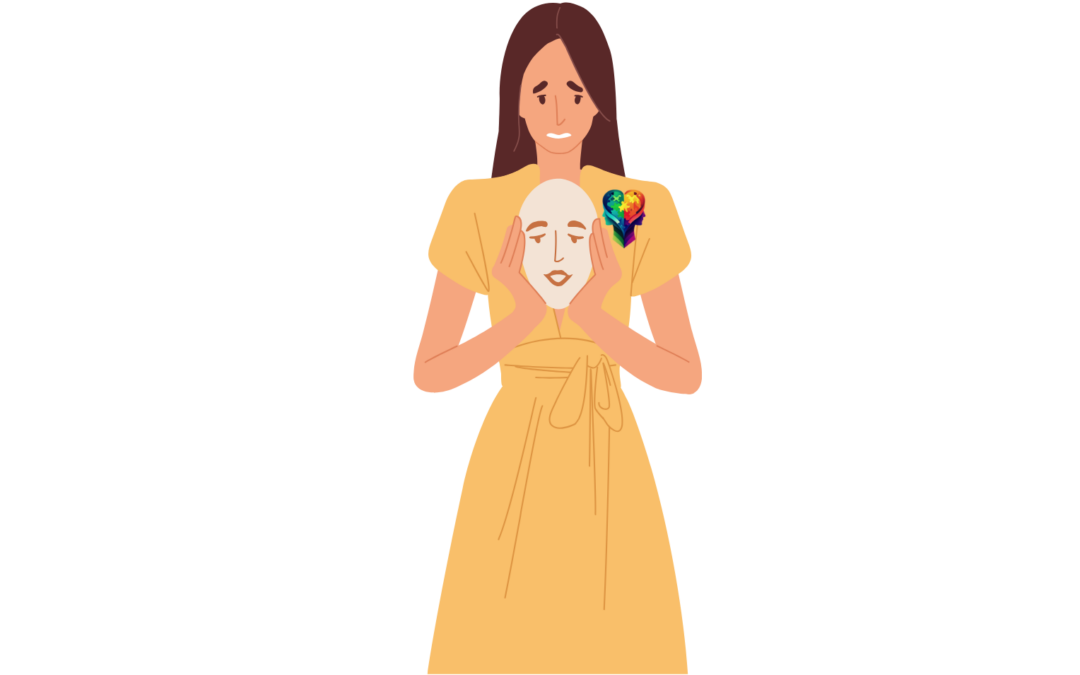Do you think you understand ADHD masking in women? What if there’s another layer to it?
Could it be that the act of ADHD masking—hiding one’s true self to fit in—is both a protective shield and a heavy burden? Masking in women with ADHD is a common but often overlooked behavior driven by societal pressures that can lead to deep emotions.
This blog post will examine masking, its effects, and how to heal for a healthier brain.
Key Insights
- ADHD masking in women often involves mimicking socially acceptable behaviors, which can lead to emotional pain, a fractured sense of self, and low self-esteem.
- Women are often underdiagnosed with ADHD due to gender bias and the subtlety of their symptoms, which can result in misdiagnosis and inadequate support.
- Embracing authenticity through unmasking can help women accept themselves for who they are, develop effective coping strategies, and build supportive communities for better mental health.
Grasping ADHD and the Masking Phenomenon
What is Attention Deficit Hyperactivity Disorder (ADHD)?
Attention Deficit Hyperactivity Disorder (ADHD) is a neurodevelopmental disorder characterized by symptoms of inattention, hyperactivity, and impulsivity. It is a lifelong condition that affects people of all ages, with varying degrees of severity and impact. ADHD is not a result of poor parenting or low intelligence; it is a complex interplay of genetic, environmental, and neurobiological factors. Understanding ADHD as a legitimate medical condition is crucial to reducing stigma and encouraging individuals to seek the help they deserve.The Experience Masking in Women with ADHD
ADHD masking is the act of mirroring the behaviors of others to fit in, a phenomenon that is particularly prevalent in women. This behavior is often driven by societal expectations and gender stereotypes that dictate women should be composed, organized, and in control. As a result, women with ADHD may feel compelled to hide their hyperactive tendencies and put on a mask of normalcy, which can lead to significant emotional and psychological pain. ADHD symptoms can manifest very differently in girls and women due to these societal pressures. While men may exhibit overt hyperactivity, women may internalize their struggles, leading to restlessness and anxiety that is hidden but debilitating. Untreated ADHD can exacerbate these challenges, leading to increased emotional pain and a lack of effective coping strategies. The constant effort to maintain this facade can leave women feeling drained and disconnected from their true selves. Despite their best efforts, many women struggle with underlying issues, such as restlessness, that can be hidden but never eliminated. The impact of ADHD masking on women’s self-esteem is significant. The constant effort to appear “normal” can chip away at one’s self-worth, leading to feelings of inadequacy and shame. The fear of judgment and rejection may cause women to hide their true selves, further isolating them and preventing them from seeking help. In the end, ADHD masking can prevent women from embracing their authentic selves and celebrating their unique strengths.Common Symptoms of ADHD in Women
Women with ADHD often exhibit symptoms that differ from those commonly associated with the disorder in men, making diagnosis more challenging. Common symptoms include:- Inattentive symptoms: Difficulty with focus, disorganization, forgetfulness, and lack of attention.
- Hyperactive symptoms: Fidgeting, restlessness, and a sense of always being “on the go.”
- Emotional symptoms: Mood swings, anxiety, and depressive tendencies.
- Executive function deficits: Difficulty with planning, organization, and time management.
The Gender Disparity in ADHD Diagnosis
ADHD diagnosis reveals a striking gender disparity, with boys being diagnosed at rates 2-9 times higher than girls. This trend continues into adulthood, though the gap narrows, with estimates indicating 5.4% of men and 3.2% of women diagnosed with adult ADHD. One reason for this disparity is that women often exhibit more inattentive symptoms than hyperactive symptoms, which can easily be overlooked. Women often present with symptoms of adult-onset ADHD later in life, often after their children have been diagnosed. This delay is partly due to their tendency to mask symptoms in order to meet societal expectations, which obscures the prevalence of ADHD. Masking behaviors in educational settings also increase the likelihood of girls’ symptoms being missed, resulting in higher diagnosis rates among males. The tendency of women to conceal their ADHD symptoms often leads to misdiagnoses of other conditions, such as anxiety or depression, complicating the diagnostic journey. Because women typically engage in more subtle masking behaviors, clinicians may struggle to identify ADHD, resulting in misdiagnosis. As a result, many women with ADHD continue to navigate life without the proper support and treatment they need.Societal Expectations and Their Impact on ADHD Masking
Societal expectations play a significant role in ADHD masking, particularly for women. Socialization often encourages women to embody nurturing, empathetic, and organized traits, which can instigate feelings of shame and inadequacy when they struggle with ADHD symptoms. The pressure to conform to traditional feminine ideals can compel women to hide their symptoms, delaying diagnosis and treatment. This societal pressure can create a sense of obligation to work harder to appear “normal,” exacerbating stress and anxiety.Recognizing ADHD Masking Behaviors in Women
Identifying the signs of ADHD masking in women can be challenging, as these behaviors are often subtle and deeply ingrained. Women with ADHD may meticulously organize their surroundings or conceal clutter to manage their symptoms. They might cancel social engagements to avoid tardiness, creating an illusion of reliability while simultaneously fostering social isolation. Women often construct highly structured environments and shy away from certain social interactions to maintain an appearance of normalcy. In social settings, they may fold their arms to suppress fidgeting, projecting an image of calmness while feeling restless internally. These behaviors enable them to blend in without drawing attention to their hyperactivity. Managing intense emotions is another area where women with ADHD frequently mask their symptoms. They may suppress their feelings by appearing calm and composed, even when grappling with internal turmoil. During conversations, women might feign engagement by taking notes or nodding, offering empty affirmations to disguise their internal struggles. These behaviors can be exhausting, leading to significant emotional tolls over time.Techniques of Social Camouflaging
Social camouflaging is a common technique used by women with ADHD to conceal their symptoms in social settings. This involves suppressing hyperactive tendencies to appear composed and adopting the mannerisms of others to blend in. Women might mimic others’ actions, such as nodding and pretending to take notes during discussions, to mask their distractions and maintain an illusion of engagement. While these camouflaging techniques can facilitate smoother navigation of social situations, they come at a cost. The relentless effort to conform and avoid missing crucial information can lead to heightened social anxiety and stress. Over time, these behaviors can leave women feeling depleted and disconnected from their authentic selves, further complicating the challenges of living with ADHD.The Cycle of Perfectionism and Overcompensation
Perfectionism often emerges as a coping mechanism among women with ADHD. This behavior stems from a heightened sensitivity to perceived flaws and an intense desire to evade criticism. Women masking ADHD frequently strive for perfection to counteract feelings of inadequacy and compensate for perceived weaknesses. This may involve maintaining elaborate organizational systems and overcommitting to activities to avoid unstructured time. While perfectionism and overcompensation can assist women in managing their ADHD symptoms, they also carry significant drawbacks. The time and energy required to uphold these behaviors can lead to elevated stress and anxiety levels. Furthermore, perfectionists may harshly judge others for their mistakes, reflecting their internal struggles and further isolating themselves from potential support networks.Illustrating ADHD Masking in Everyday Life
ADHD masking can manifest in various ways throughout daily life, including:- Concealing restlessness and fidgeting in social situations: Women might keep their arms folded or sit on their hands to suppress fidgeting, projecting an image of composure while feeling restless internally.
- Employing coping strategies such as deep breathing or meditation to manage anxiety: These techniques can help alleviate internal chaos but may also obscure underlying ADHD symptoms.
- Overcompensating with perfectionism to mask disorganization and lack of focus: Striving for perfection can serve as a shield against struggles with organization and attention, yet it often leads to increased stress and burnout.
- Avoiding specific situations or activities that may trigger ADHD symptoms: Women might cancel social engagements to evade tardiness or feelings of overwhelm, resulting in social isolation.
- Utilizing technology, such as reminders and alarms, to maintain organization and stay on track: While these tools can be beneficial, they may also mask difficulties with executive function.









